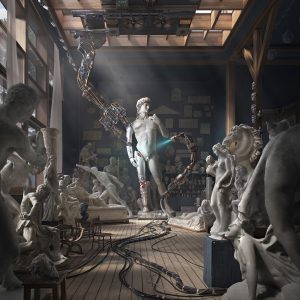In the beating heart of the digital world, where algorithms and pixels reign supreme, there emerges an artist unafraid to blend classical art with shades of modernity. Vittorio Bonapace, a name echoing amidst the chants of NFT auctions, invites us on a journey where the boundary between the physical and digital thins to transparency.
Born in Rieti in 1986, Bonapace’s trajectory begins in the epic arena of the Academy of Fine Arts in Rome, culminating in the opulent halls of the Teatro dell’Opera in Rome. Yet, it’s his move to the bustling London, and his immersion into the dizzying world of Cityscape Digital, that pulls him into the whirlpool of digital art.
Imagine an auction, in 2050, where machines curate the event, and mannequins bid for the essence of human nature. This isn’t a scene from a sci-fi film but the artistic vision of Bonapace in “Memento Mori /2023”. The painting, inspired by Géricault’s controversial “Le Radeau de la Méduse”, raises questions that oscillate between the ethical and the aesthetic. What does human nature truly signify in the age of artificial intelligences?
Yet, he doesn’t stop there. The evolution continues with “God Save the Queen’ /2023”, a portrait of the British queen, not molded by human hands but crafted by machines. The queen’s grandeur and elegance merge with themes of solitude and isolation, a deep exploration of human emotions hidden behind the regal facade.
Bonapace is not just an artist but a storyteller. Every piece of his tells a tale, a conflict between humanity and divinity, between what’s real and what’s digital. It’s a battle for identity, for value, for the very essence of what it means to be human in an increasingly tech-dominated world.
If art is a reflection of society, then Bonapace gifts us a mirror, not to show us as we are now, but to unveil what we might become. An artist of paradox, Vittorio Bonapace challenges us to reflect, to question, and, above all, to feel in a world where sentiment can seem increasingly obsolete.






